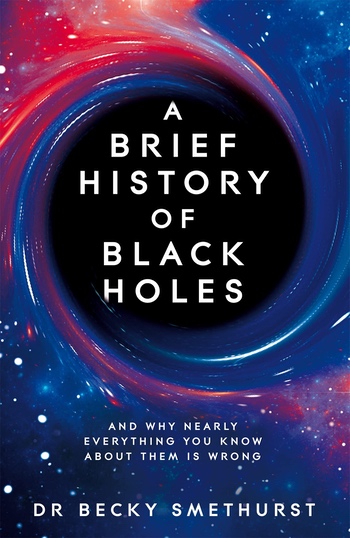 |
Review: A Brief History of Black Holes
by Jeff Foust
Monday, January 9, 2023
A Brief History of Black Holes: And Why Nearly Everything You Know About Them Is Wrong
by Becky Smethurst
Macmillan, 2022
hardcover, 288 pp., illus.
ISBN 978-1-5290-8670-6
US$29.95
Black holes probably exist. That was the conclusion of a study publicized last week that examined whether the phenomena widely believed to be black holes might instead be an ultracompact object formed of exotic matter, dubbed a “boson star”. The analysis, though, concluded that such a boson star would last for only a fraction of a second before exploding into a less dense object or collapsing into—you guessed it—a black hole.
| “A black hole isn’t the absence of something; it’s the presence of everything; matter in its densest possible form,” she writes. |
The black hole’s place in our understanding of the universe has become increasing secure over the last half-century. They have gone from theoretical constructs to objects whose existence was inferred by various phenomena to, in recent years, detections by gravitational wave observatories and direct imaging. Their place in popular culture has been even stronger: objects with voracious appetites that suck in anything in their path, never to be seen again.
But in A Brief History of Black Holes, Becky Smethurst, an astrophysicist and science communicator at the University of Oxford, suggests it’s time to rethink our concepts of black holes. The science about them is correct, but our perception of them as holes that objects fall into is all wrong: they are massive mountains that are the brightest objects in the universe.
The book is a popular science overview of our understanding of black holes, and more broadly our evolving understanding of the universe. She balances the science with the scientists to offer a broader perspective of how the concept of black holes emerged, backed by both theory and observations. She goes into some level of detail, including concepts like the Tolman-Oppenheimer-Volkoff limit (the maximum mass of a neutron star) without losing the reader.
Perhaps the most novel argument she makes (and the substance behind the book’s subtitle) is that our conceptualization of black holes is all wrong. “A black hole isn’t the absence of something; it’s the presence of everything; matter in its densest possible form,” she writes. “I like to think of them more like mountains of matter than holes in the ground.”
That extends to the “black” part of the name, noting that the supermassive black holes in the center of galaxies in particular are incredibly bright in X-ray and radio bands because of their accretion disks. “To me, it once again represents one of the most misunderstood concepts about black holes; they’re not ‘black’, they are the brightest things in the entire Universe. Completely unmissable, blazingly bright mountains of matter.”
The term “black hole,” she writes, appears to date back to a 1961 conference where physicist Robert Dicke compared what were then called “gravitationally completely collapsed objects” to the Black hole of Calcutta, the infamous overcrowded prison. Within a decade, the term “black hole” made its way into both popular and scientific literature. She writes she would have preferred a term like “dark star” proposed by John Mitchell in the 18th century for stars so big that light could not escape them.
That said, we are likely stuck with “black hole” given how strongly the term is entrenched in both science and popular culture. But after reading A Brief History of Black Holes, you will have a better appreciation of what those objects really are, and a reminder that names can be deceiving.
Note: we are using a new commenting system, which may require you to create a new account.
No comments:
Post a Comment